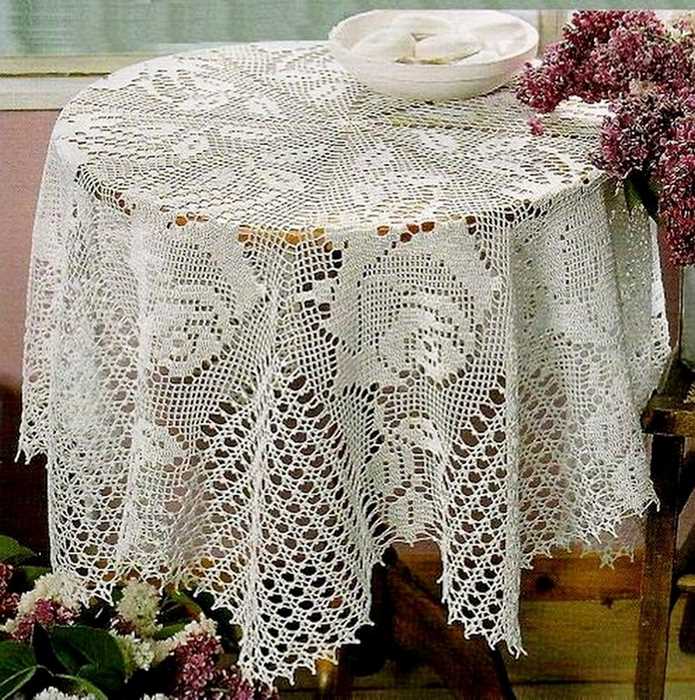
Knitting tablecloths can add a touch of elegance to any dining table or side table. Whether you are looking to create a stunning centerpiece or simply enhance the look of your furniture, knitting a tablecloth can be a rewarding and relaxing project.
One popular tablecloth pattern is the lace design. This delicate and intricate pattern is perfect for adding a touch of elegance to any room. The lace design creates a beautiful, openwork pattern, which gives the tablecloth a light and airy look. This pattern is versatile and can be adapted to fit any size table.
Another popular pattern is the cable design. This pattern is perfect for creating a cozy and warm atmosphere. The cable pattern is created by twisting and crossing stitches, which creates a textured and three-dimensional effect. This pattern works well for a larger tablecloth, as the cables add both visual interest and weight to the fabric.
When choosing a knitting tablecloth pattern, it is important to consider the size and style of your table. If you have a small table, a simpler pattern with fewer stitches may be more appropriate. However, if you have a larger table, a more intricate pattern with multiple stitch patterns may be desired.
No matter which pattern you choose, knitting a tablecloth can be a fun and rewarding project. It allows you to showcase your creativity and create a unique piece for your home. So grab your knitting needles and start creating a beautiful tablecloth that will be the envy of all your guests!
What is a Knitting Tablecloth Pattern?
Knitting is a popular craft that involves creating fabric by interlocking loops of yarn using knitting needles. It is a versatile and relaxing hobby, with numerous patterns available for a wide range of projects. One popular project for knitting enthusiasts is creating tablecloths.
A knitting tablecloth pattern is a set of instructions that guides knitters in creating a decorative tablecloth using various knitting techniques. These patterns typically include details on the size of the tablecloth, the type of yarn and knitting needles to use, and the specific stitches and techniques required to achieve the desired design.
Knitting tablecloth patterns can vary in complexity, ranging from simple lace patterns to intricate designs with multiple colors and stitch combinations. They can be created in different shapes, such as square, rectangular, or round, to suit various table sizes and styles. Some patterns may also include embellishments, such as knitted appliques or crochet borders, to add extra flair to the finished tablecloth.
When following a knitting tablecloth pattern, it is important for knitters to carefully read and understand the instructions before beginning the project. They should also have some experience with knitting basics, such as casting on, knitting, purling, and binding off, as these techniques are commonly used in tablecloth patterns.
Overall, a knitting tablecloth pattern provides knitters with the opportunity to create a beautiful and decorative piece for their dining table or as a gift for someone special. It allows them to showcase their skills and creativity while enjoying the therapeutic and fulfilling process of knitting.
Choosing the Right Yarn for Your Knitting Tablecloth Pattern
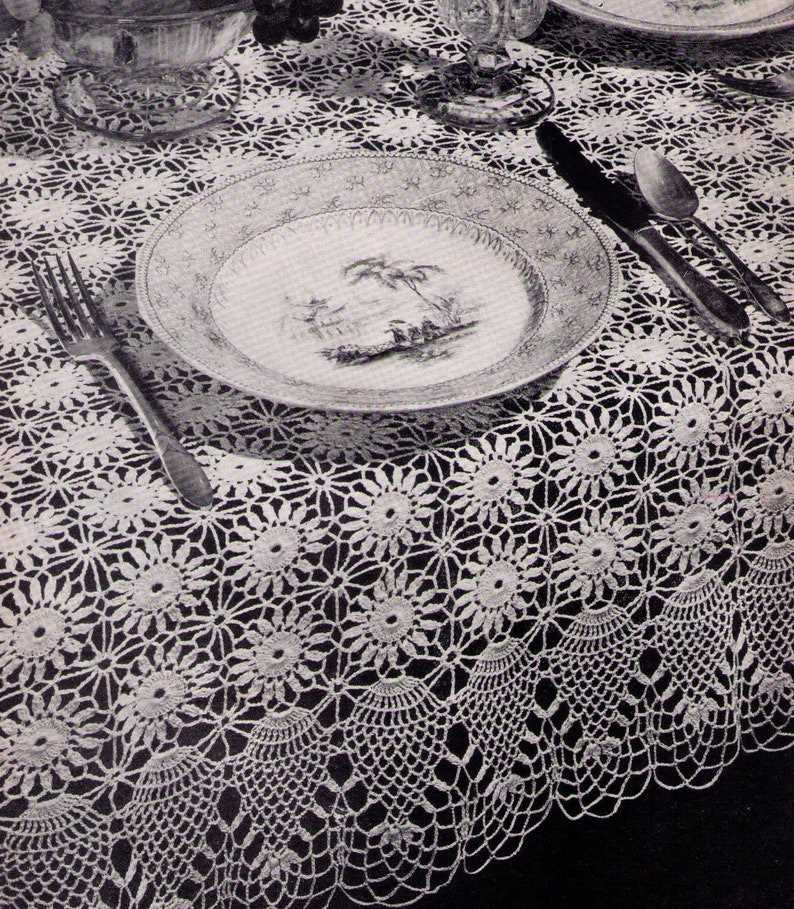
When it comes to knitting a beautiful tablecloth, one of the most important factors to consider is the choice of yarn. The yarn you select can greatly impact the final look and feel of your finished tablecloth. Therefore, it is crucial to choose the right type of yarn that suits your desired pattern and desired outcome.
1. Fiber Content: The first thing to consider when choosing yarn for your knitting tablecloth pattern is the fiber content. Different fibers have different characteristics and will affect the drape and texture of your finished tablecloth. Common yarn fibers used for tablecloths include cotton, linen, and bamboo, as they provide a crisp and sturdy texture that can withstand frequent use.
2. Weight and Thickness: The weight and thickness of the yarn also play a significant role in determining the overall look of your tablecloth. Thicker yarns will create a more substantial and cozy tablecloth, while lighter yarns can produce a delicate and airy result. Consider your desired aesthetic and functionality when selecting the weight and thickness of the yarn.
3. Color and Pattern: The color and pattern of your yarn are also important considerations. For a classic and elegant look, neutral or pastel shades are often chosen. Alternatively, you can opt for bold and vibrant colors to make a statement. Additionally, the pattern you choose may also influence the yarn selection. Yarns with good stitch definition are ideal for intricate lace or cable patterns, whereas smoother yarns work well for simpler designs.
4. Care Instructions: Lastly, consider the care instructions for the yarn you choose. Tablecloths often require frequent washing, so it is essential to select a yarn that is machine washable and can withstand regular use without losing its shape or color. Wool-based yarns, for example, may require more delicate care compared to cotton or acrylic yarns.
Overall, selecting the right yarn for your knitting tablecloth pattern is a crucial step in achieving the desired look and functionality of your finished piece. Take into account factors such as fiber content, weight and thickness, color and pattern, and care instructions to ensure the success of your knitting project.
Essential Knitting Techniques for Tablecloth Patterns
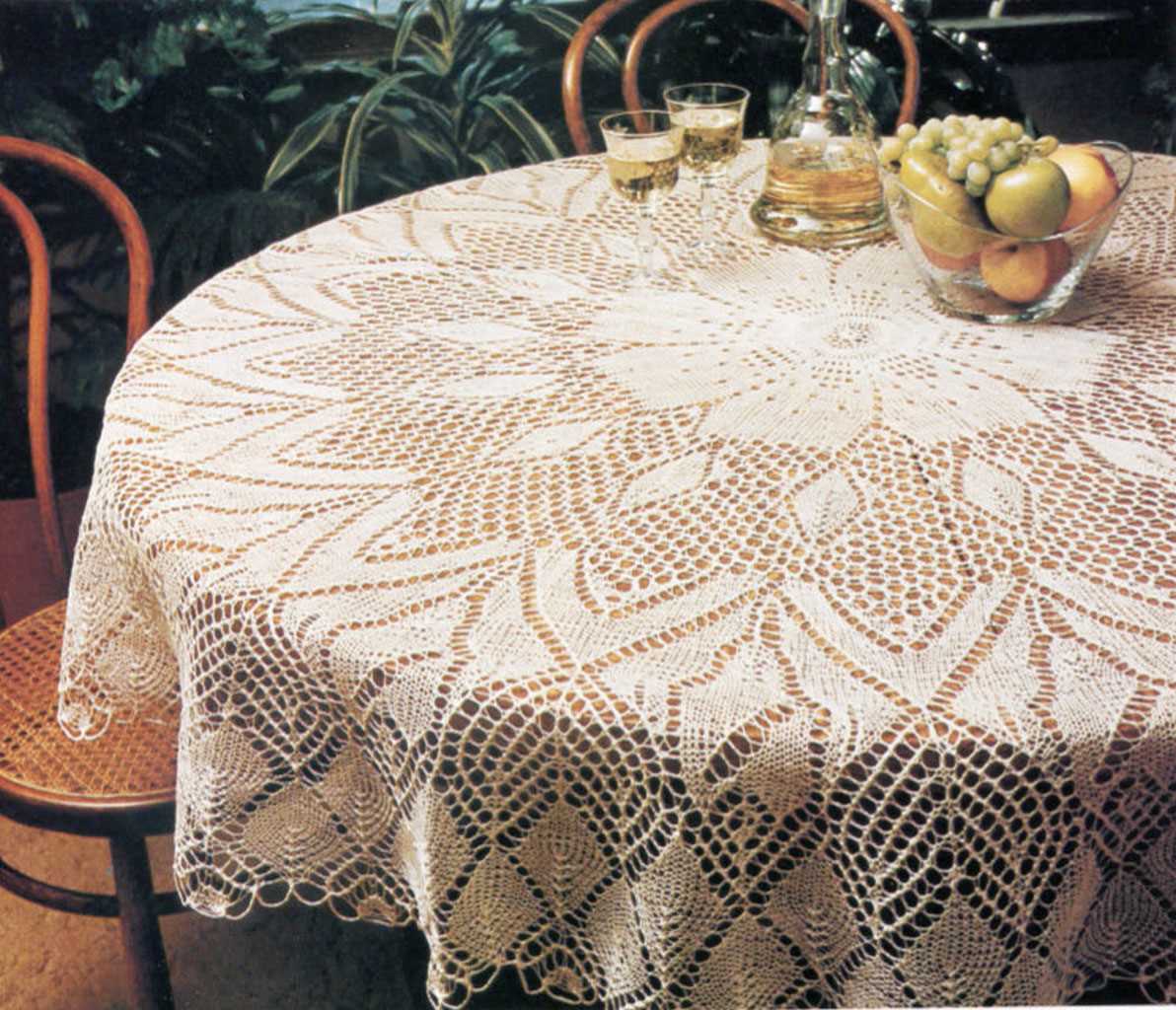
When knitting a tablecloth pattern, there are several essential techniques that every knitter should be familiar with. These techniques will help you create a beautiful and durable tablecloth that will impress your guests.
1. Knit and Purl Stitches: The knit and purl stitches are the foundation of knitting and form the basis of most tablecloth patterns. It’s important to master these basic stitches before attempting more complex patterns. The knit stitch creates a smooth, v-shaped stitch, while the purl stitch creates a bumpier, p-shaped stitch. By combining these two stitches in different patterns, you can create a variety of textures and designs on your tablecloth.
2. Lace Knitting: Lace knitting is a popular technique used in many tablecloth patterns. It involves creating patterns of holes and eyelets in the fabric, which give the tablecloth a delicate and airy look. To knit lace patterns, you will need to learn how to create yarn overs (yo), knit two togethers (k2tog), and slip-slip-knit (ssk) stitches. These techniques will allow you to manipulate the stitches to create intricate lace designs.
3. Blocking: Blocking is an important step in finishing your tablecloth. It involves wetting the knitted fabric, shaping it to the desired dimensions, and allowing it to dry in that shape. Blocking helps even out the stitches and gives the tablecloth a polished and professional appearance. To block a tablecloth, you will need special blocking boards or mats, T-pins, and a spray bottle. Follow the specific blocking instructions for your tablecloth pattern to ensure the best results.
4. Chart Reading: Many tablecloth patterns are presented in chart form, which uses symbols and grids to represent the stitches. Learning to read knitting charts is essential for understanding the pattern and keeping track of your progress. Start by learning the basic symbols, such as circles for knit stitches and squares for purl stitches. Then, practice interpreting the charts and following the pattern instructions accordingly.
- 5. Sizing and Measurements: Tablecloths come in various sizes, so it’s important to understand how to adjust the pattern to fit your desired dimensions. You will need to take accurate measurements of your table and calculate how many stitches and rows are needed to achieve the desired size. Additionally, you may need to adjust the gauge of your knitting to ensure that the tablecloth turns out the right size.
- 6. Edging Techniques: Adding a decorative edge to your tablecloth can elevate its appearance and give it a finished look. There are various edging techniques you can use, such as picot bind-off, scalloped edges, or lace edging patterns. These techniques involve adding extra stitches or creating specific stitch patterns along the edges of the tablecloth. Experiment with different edging techniques to find the one that complements your tablecloth design.
In conclusion, mastering these essential knitting techniques will help you create stunning tablecloth patterns. Whether you’re a beginner or an experienced knitter, practicing these techniques will enhance your knitting skills and allow you to create unique and beautiful tablecloths that will be treasured for years to come.
Basic Knitting Stitches
When it comes to knitting, there are several basic stitches that every knitter should know. These stitches form the foundation of most knitting projects and can be combined in various ways to create different patterns and textures. Whether you are a beginner or an experienced knitter, mastering these basic stitches will give you the skills to tackle any knitting project with confidence.
1. Knit Stitch
The knit stitch, also known as the plain stitch, is the most basic and commonly used stitch in knitting. To create this stitch, insert your right needle into the front of the first stitch on the left needle, wrap the yarn around the right needle, and pull it through the stitch to create a new loop. Slip the original stitch off the left needle, and you have completed one knit stitch.
2. Purl Stitch
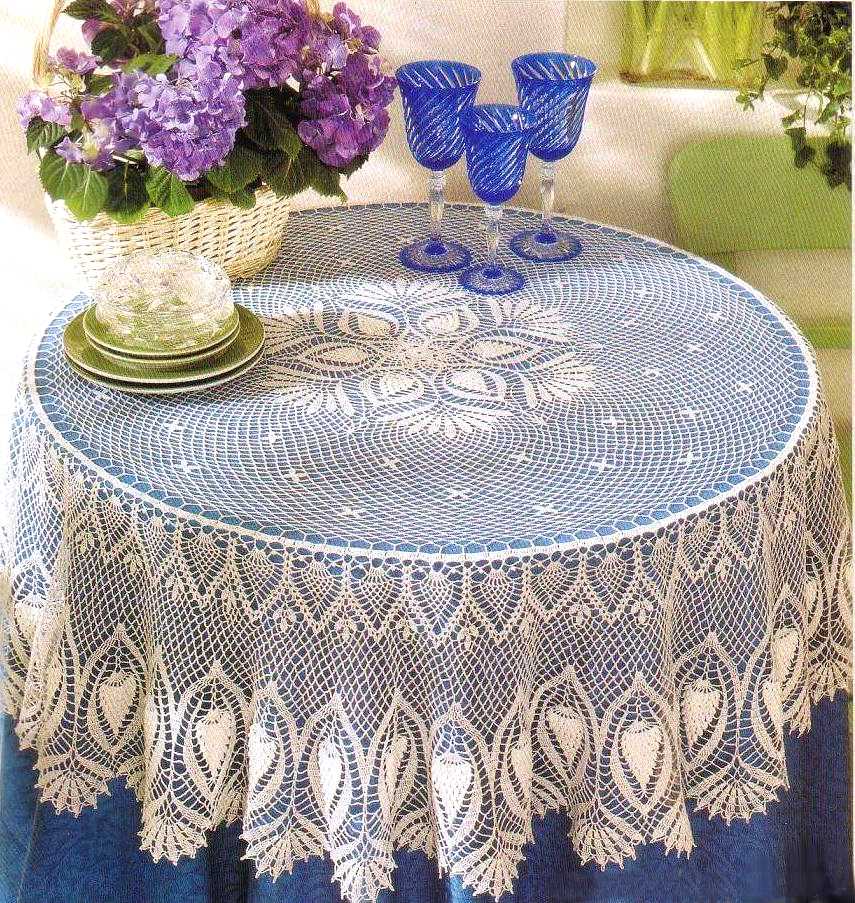
The purl stitch is the opposite of the knit stitch and is used to create a smooth, textured surface on the right side of the fabric. To purl, insert your right needle from right to left into the front of the first stitch on the left needle, wrap the yarn around the right needle, and pull it through the stitch to create a new loop. Slip the original stitch off the left needle, and you have completed one purl stitch.
These two stitches, knit and purl, are the foundation of all knitting patterns. By combining them in different ways, you can create a wide variety of designs and textures. Practice these stitches until you feel comfortable with them, and you will be well on your way to becoming a skilled knitter.
Increase and Decrease Techniques
In knitting, increase and decrease techniques are essential skills to learn. These techniques allow you to shape your knitting project, creating curves, angles, and different dimensions. By increasing stitches, you can make your work wider or longer, while decreasing stitches help create tapered edges or stitch patterns.
Increases: There are several ways to increase stitches in knitting. One common method is the yarn over (YO) increase, where you simply wrap the yarn around the needle without knitting a stitch. Another method is the knit front and back (KFB) increase, where you knit into the front and back of the same stitch to create two stitches from one. The make one (M1) increase is another popular method, involving picking up the horizontal strand between stitches and knitting into it.
Decreases: Decreasing stitches is essential when shaping your knitting project. Common decrease techniques include knit two together (K2tog), where you knit two stitches together as if they were one; slip, slip, knit (SSK), where you slip two stitches knitwise, then insert the left needle into the front loops of both stitches and knit them together; and the centered double decrease (CDD), which involves slipping two stitches together as if to knit, knitting the next stitch, and then passing the slipped stitches over the knit stitch.
By mastering increase and decrease techniques, knitters can take their projects to the next level, creating intricate lace patterns, shaping garments, and adding dimension to their work. Practice these techniques and experiment with different stitch patterns to expand your knitting skills and create beautiful and unique projects.
Lace Knitting Techniques
Lace knitting is a popular technique used to create delicate and intricate patterns in knitted fabric. It involves creating decorative holes and openwork designs by strategically placing yarn overs and decreases. By using these techniques, knitters can create beautiful lace shawls, scarves, and even tablecloths.
One of the fundamental techniques used in lace knitting is the yarn over (YO). This simple maneuver involves bringing the working yarn to the front of the work and then wrapping it around the needle before continuing with the next stitch. The yarn over creates an extra stitch and results in a decorative hole in the fabric. Yarn overs are often paired with decreases, such as a knit two together (K2tog) or a slip, slip, knit (SSK), to maintain the stitch count and create the desired lace pattern.
Knitters also use various stitch patterns to create beautiful lace designs. Some common lace stitch patterns include the eyelet stitch, the feather and fan stitch, and the diamond stitch. These patterns often combine a series of yarn overs and decreases to create intricate motifs and textures. Knitters can find lace patterns in knitting books, magazines, or online resources, or they can design their own patterns using graph paper or knitting software.
To successfully knit lace, it is important to pay attention to tension and blocking. Looser tension allows the lace pattern to open up, while tighter tension can result in a denser fabric. Blocking, which involves wetting the knitted piece, stretching it into shape, and letting it dry, helps to even out stitches and enhance the lace pattern. Blocking wires and pins are often used to achieve precise shaping.
Overall, lace knitting is a rewarding and versatile technique that allows knitters to create beautiful and intricate designs. It may require some practice and patience, but the end result is worth it. Whether you’re knitting a lace shawl or a tablecloth pattern, mastering lace techniques can elevate your knitting projects to a new level of elegance.
Popular Knitting Tablecloth Patterns
If you have a passion for knitting and want to add a touch of elegance to your home, knitting a tablecloth can be a perfect project for you. Tablecloths not only add beauty to your dining area but also provide protection for your table. They can be an heirloom piece that can be passed down through generations. In this article, we will explore some popular knitting tablecloth patterns that you can try.
Lace Knitting Tablecloth
Lace knitting tablecloths are a timeless classic. The delicate and intricate patterns add an exquisite touch to your dining table. These tablecloths feature lace motifs such as leaves, flowers, or geometric shapes. The patterns may require advanced knitting skills due to the intricate lacework involved. However, they are definitely worth the effort as they create a stunning centerpiece for your table.
Cable Knitting Tablecloth
A cable knitting tablecloth is perfect if you prefer a more textured and cozy look for your table. The cables add depth and dimension to the fabric, creating an interesting visual effect. You can choose from a variety of cable patterns, such as braids, twists, or knots, to create a unique and personalized tablecloth. This style is suitable for both traditional and modern décor.
Colorful Geometric Knitting Tablecloth
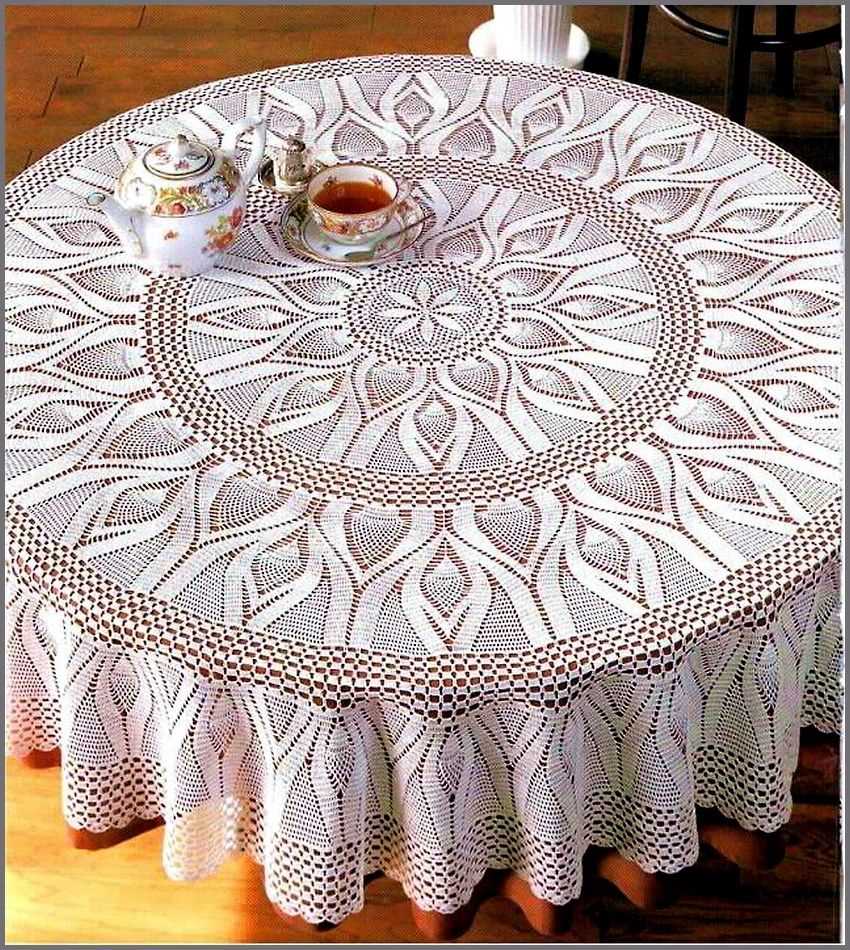
If you want to add a pop of color to your dining area, a colorful geometric knitting tablecloth is an excellent choice. These tablecloths feature bold and vibrant patterns inspired by geometric shapes like squares, triangles, or chevrons. They can be knit using multiple colors and different stitch patterns to create a visually striking piece. These tablecloths work well in contemporary and eclectic interiors.
There is a wide range of knitting tablecloth patterns available, ranging from simple and beginner-friendly designs to complex and intricate ones. Choose the pattern that suits your skill level and personal style, and enjoy the process of creating a beautiful and functional piece for your home.
Knitting Tools and Materials for Tablecloth Patterns
When starting a tablecloth knitting project, it is important to gather all the necessary tools and materials. Having the right resources at hand will make the knitting process much easier and enjoyable. Here are some essential items that you will need:
Knitting Needles
- A set of knitting needles is essential for any knitting project. For tablecloth patterns, it is recommended to use long straight needles or circular needles, depending on your personal preference.
- Choose needles that are the appropriate size for your desired yarn weight. Thinner yarns will require smaller needles, while thicker yarns will require larger needles.
- It is also helpful to have a set of double-pointed needles for knitting small sections, such as the center of lace motifs.
Yarn
- Selecting the right yarn is crucial for achieving the desired look and texture of your tablecloth. Opt for a high-quality, durable yarn that is suitable for table linens.
- Cotton yarn is a popular choice for tablecloth patterns due to its absorbency and softness. It is also easy to care for and can withstand frequent use.
- Consider the color and pattern of the yarn, keeping in mind the overall aesthetic of your tablecloth.
Tapestry Needle
A tapestry needle is essential for weaving in loose ends and sewing pieces together. Choose a needle that is large enough to accommodate the thickness of your yarn but not too large to distort the stitches.
Stitch Markers and Row Counter
Stitch markers are useful tools for marking specific stitches or sections in your tablecloth pattern. They can help you keep track of stitch counts and pattern repeats.
A row counter is also beneficial for keeping track of your progress and ensuring accuracy. It can be a physical counter or a digital one, whichever you find more convenient.
Pattern and Chart
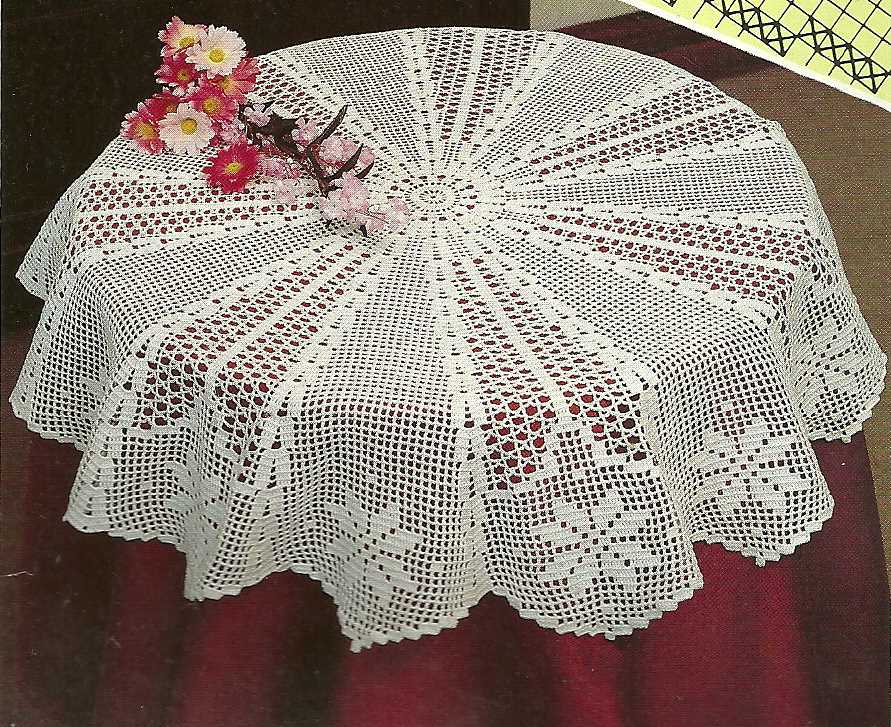
Lastly, a printed copy or digital version of the tablecloth pattern is crucial for following along and keeping track of the instructions. Some tablecloth patterns also include charts for lace or intricate stitch patterns, which can be helpful visual guides.
Make sure to read and understand the pattern before starting, and keep it within reach throughout the knitting process.
Tips and Tricks for Knitting Tablecloth Patterns
Knitting a tablecloth can be a challenging yet rewarding project. With the right patterns and techniques, you can create beautiful and intricate designs that will impress everyone who sees your finished tablecloth. Here are some tips and tricks to help you successfully knit tablecloth patterns:
1. Choose the right yarn and needle size
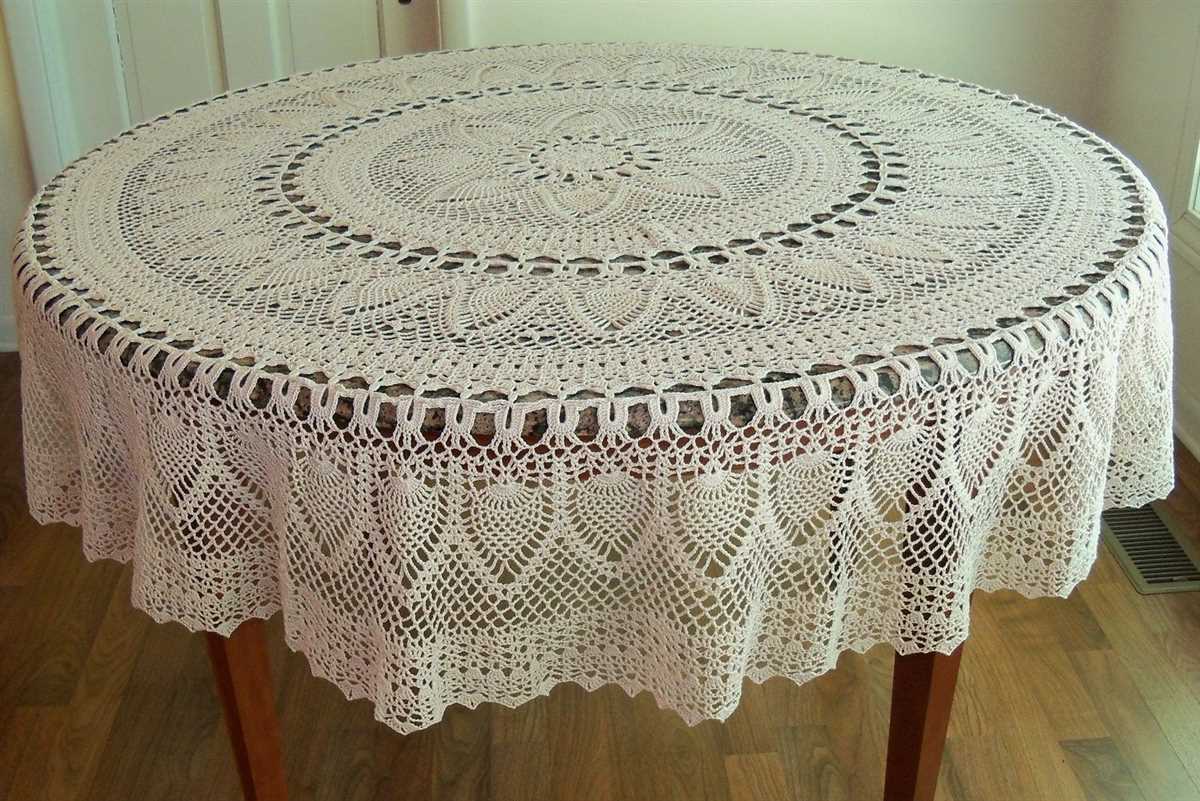
When starting a tablecloth project, it’s crucial to select the appropriate yarn and needle size. A finer yarn, such as lace weight or fingering weight, will help create delicate and intricate patterns. Choose a needle size that matches the yarn weight and allows you to achieve the desired tension and gauge. Remember to check the pattern for specific recommendations on yarn and needle size.
2. Use stitch markers
Stitch markers can be extremely helpful when knitting tablecloth patterns, especially those with complex stitch patterns or multiple stitch repeats. By placing stitch markers at key points in the pattern, you can easily keep track of your progress and ensure that you’re following the correct stitch count. This will save you from frequent stitch counting and help prevent mistakes.
3. Block your tablecloth
Blocking is an essential step in finishing any knitting project, including tablecloths. After completing the knitting, soak your tablecloth in lukewarm water and gently squeeze out the excess moisture. Then, carefully stretch and shape the tablecloth to its desired dimensions, pinning it in place with rustproof T-pins. Allow it to dry completely before unpinning. Blocking will even out your stitches, enhance the lace patterns, and give your tablecloth a polished look.
4. Take breaks and rest your hands
Knitting a tablecloth can be a lengthy process that requires many hours of repetitive hand movements. It’s important to take regular breaks to rest your hands and prevent fatigue or strain. Stretch your fingers, rotate your wrists, and do simple exercises to keep your hands and fingers flexible. This will help avoid discomfort and ensure that you can continue knitting without any issues.
5. Keep track of your progress
As tablecloth patterns can be quite intricate, it’s crucial to keep track of your progress to avoid mistakes or confusion. Use a row counter, keep a written record of the pattern, or use a digital pattern tracker app to help you stay on track. Mark off completed rows or repeats, and double-check each row before moving on to the next. This will help you maintain accuracy and ensure a beautiful end result.
By following these tips and tricks, you’ll be well-equipped to tackle knitting tablecloth patterns with confidence and skill. With practice and patience, you’ll create stunning tablecloths that will be cherished for years to come.
Common Mistakes to Avoid in Knitting Tablecloth Patterns
Knitting a tablecloth can be a rewarding project that adds a touch of elegance to any dining room or kitchen. However, there are some common mistakes that knitters often make when following tablecloth patterns. By being aware of these mistakes, you can ensure that your tablecloth turns out beautiful and without any flaws.
1. Not checking gauge
One of the most important steps in knitting any pattern is checking gauge. Many knitters skip this step and end up with a tablecloth that is either too large or too small. Take the time to knit a swatch and measure it to ensure that your stitches and rows match the pattern. This will help you achieve the correct dimensions and ensure that your tablecloth fits properly.
2. Using the wrong yarn
Choosing the right yarn is crucial for the success of your tablecloth. Some knitters make the mistake of using a yarn that is too heavy or too thin for the pattern, resulting in an unbalanced finished product. Make sure to check the yarn weight recommended in the pattern and choose a yarn that matches it. This will help you achieve the desired drape and texture of the tablecloth.
3. Not keeping track of pattern repeats
Tablecloth patterns often involve repeating patterns or motifs. It’s important to keep track of these repeats to ensure that your tablecloth has a consistent design throughout. Use stitch markers or a row counter to help you keep track of where you are in the pattern and avoid any mistakes or inconsistencies.
4. Ignoring blocking
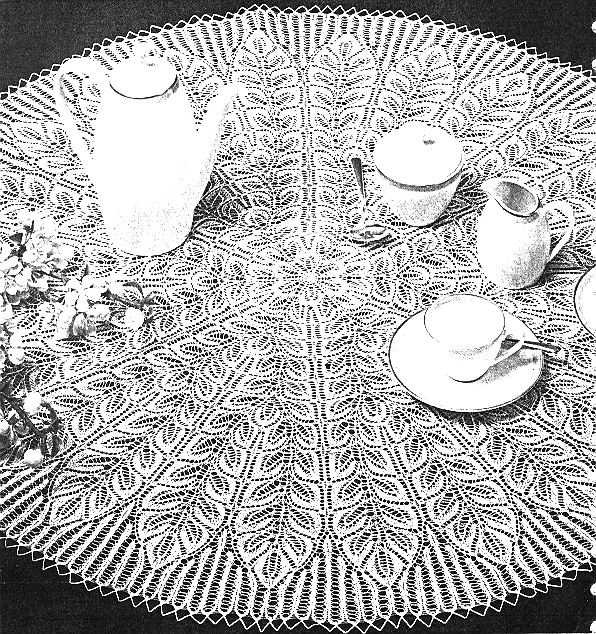
Blocking is an essential step in finishing a knitted tablecloth. Some knitters skip this step, resulting in a tablecloth that doesn’t lay flat or has uneven stitches. Take the time to block your tablecloth according to the instructions in the pattern. This will help you achieve a professional-looking finish and enhance the beauty of your tablecloth.
Avoiding these common mistakes will help you create a stunning knitted tablecloth that you can be proud of. Take the time to carefully follow the pattern, check gauge, choose the right yarn, keep track of repeats, and block your finished tablecloth. With these steps in mind, your tablecloth will be a beautiful addition to your home décor.
Blocking and Finishing Techniques for Knitted Tablecloth Patterns
Blocking and finishing are crucial steps in creating a beautiful and professional-looking knitted tablecloth. These techniques can help to even out stitches, open up lace patterns, and give your tablecloth a polished and finished appearance. Here are some essential tips for blocking and finishing your knitted tablecloth patterns:
1. Wet Blocking: Wet blocking is the most common method for blocking knitted items. Start by thoroughly soaking your finished tablecloth in cold water, ensuring that it is completely saturated. Gently squeeze out excess water, being careful not to wring or twist the fabric. Lay the tablecloth flat on a clean and absorbent surface, such as a towel or blocking mat. Use rust-proof blocking pins to secure the edges and shape the tablecloth to its desired dimensions. Allow the tablecloth to dry completely before removing the pins.
2. Steam Blocking: Steam blocking is an alternative method that can be used for delicate or non-absorbent yarns. Place a damp cloth over your tablecloth and press down with a steam iron on a low setting, hovering over the fabric without touching it directly. The steam will help to relax the stitches and set the desired shape. Be cautious not to apply too much heat or pressure, as it can damage the yarn or distort the pattern. Allow the fabric to cool and dry before removing the cloth and assessing the results.
Finishing Techniques:
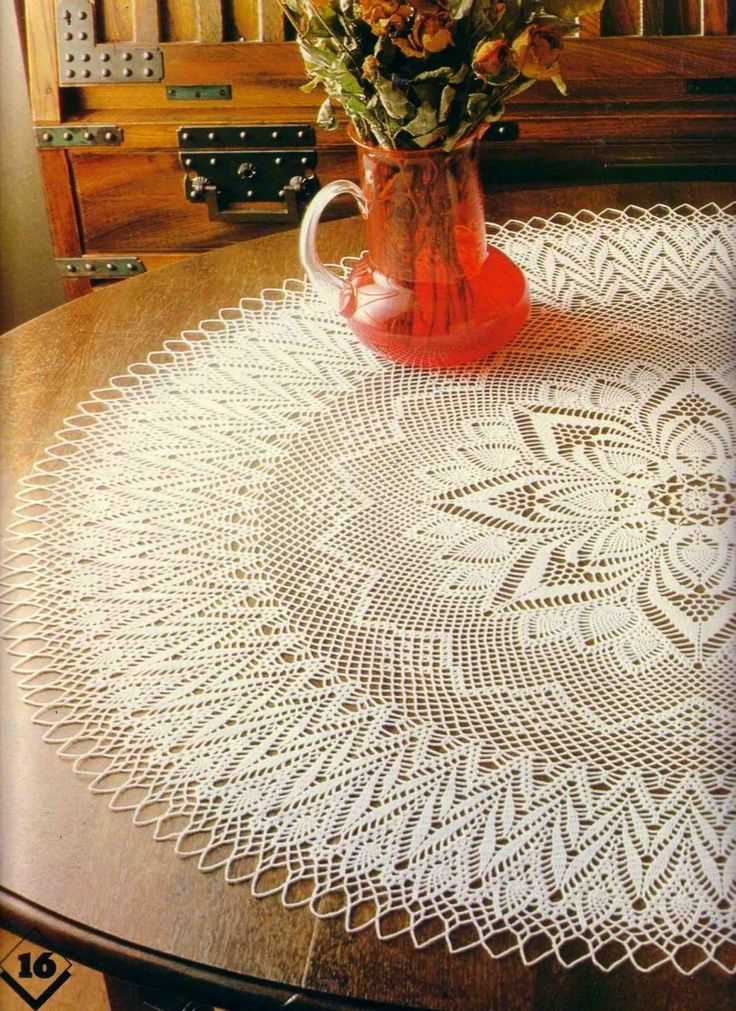
Once your tablecloth is blocked and dry, there are a few additional finishing techniques to enhance the overall appearance:
- Weaving in Ends: Use a tapestry needle to weave in any loose yarn ends from color changes or joining new yarn. Conceal the ends within the stitches of the fabric, ensuring they are secure and will not unravel over time.
- Edging: Consider adding a decorative edging to your tablecloth to give it a polished and finished look. There are various edging patterns available, such as picot, lace, or scallop motifs. Choose one that complements the overall design of your tablecloth and carefully knit or crochet it along the edges.
- Blocking the Edging: After adding the edging, block it separately from the main body of the tablecloth to ensure it lays flat and matches the blocked dimensions. This will help to create a cohesive and professional finish.
By following these blocking and finishing techniques, your knitted tablecloth patterns will be transformed into stunning and elegant pieces that will enhance any dining or living space. Take your time and enjoy the process, and soon you’ll have a treasured heirloom to be proud of.
Adapting Tablecloth Patterns to Different Sizes and Designs
When it comes to knitting tablecloths, one of the challenges is adapting the patterns to different sizes and designs. Fortunately, there are several techniques and strategies that can be employed to successfully modify tablecloth patterns to suit individual preferences and requirements.
1. Adjusting the Number of Stitches: One way to adapt a tablecloth pattern is by adjusting the number of stitches. This can be done by adding or subtracting stitches at the beginning or end of each row. By increasing or decreasing the number of stitches, it is possible to achieve the desired size for the tablecloth.
2. Changing the Pattern Repeat: Another method to adapt a tablecloth pattern is by changing the pattern repeat. This involves altering the number of rows or stitches in the pattern repeat to create a larger or smaller design. By adjusting the repeat, it is possible to customize the size of the tablecloth while maintaining the overall aesthetic of the original pattern.
3. Swapping Yarns and Needle Sizes: Additionally, swapping yarns and needle sizes can also help in adapting a tablecloth pattern. Using a thicker yarn and larger needles will result in a larger tablecloth, while using a thinner yarn and smaller needles will yield a smaller tablecloth. It is important to keep in mind that the fabric’s drape and texture may vary depending on the chosen yarn and needle size.
4. Creating Custom Designs: For those looking to create custom tablecloth designs, adapting existing patterns is a great starting point. By combining different stitch patterns, adding or removing lace motifs, or incorporating colorwork, it is possible to create unique tablecloth designs that suit individual styles and preferences.
With these techniques and strategies in mind, knitting enthusiasts can confidently adapt tablecloth patterns to different sizes and designs, allowing for endless possibilities and creativity in their projects.
Inspiration and Ideas for Knitting Tablecloth Patterns
Knitting a tablecloth can be a challenging yet rewarding project. With endless possibilities for designs and patterns, it can be overwhelming to choose the perfect one for your home. This article has provided a variety of ideas and inspiration for knitting tablecloth patterns, from traditional lace patterns to modern geometric designs. Whether you prefer a vintage look or a contemporary style, there is something for everyone.
By exploring different stitches, color combinations, and textures, you can create a tablecloth that is unique and personalized. Consider incorporating different knitting techniques, such as cables, bobbles, or lace, to add interest and depth to your design. Experiment with different yarn weights and fiber types to achieve the desired look and feel.
Whether you are an experienced knitter or a beginner, there are patterns available for all skill levels. Start with a simple design if you are just starting out, and gradually challenge yourself with more complex patterns as you gain confidence and experience.
Inspiration Ideas for Knitting Tablecloth Patterns:
- Lace patterns: Create an elegant and delicate tablecloth using intricate lace patterns. Choose from traditional lace motifs like leaves, flowers, or chevrons, or opt for more modern geometric lace designs.
- Colorwork: Experiment with different color combinations to create stunning tablecloths. Fair Isle, intarsia, or stranded colorwork techniques can be used to add vibrant patterns and motifs.
- Texture: Add depth and texture to your tablecloth by incorporating stitches like cables, bobbles, or popcorn stitches. These elements can create a tactile and visually interesting piece.
- Stripes and geometric patterns: Create a bold and modern look by knitting tablecloths with stripes or geometric patterns. Choose contrasting colors and play with different stripe widths and arrangements for a unique design.
- Openwork and eyelet patterns: Give your tablecloth a light and airy feel by incorporating openwork and eyelet patterns. These designs are perfect for warmer months or for adding a touch of elegance to any table setting.
Remember to always read and follow the pattern instructions carefully, as different patterns may have specific requirements and techniques. Also, don’t be afraid to customize and modify patterns to suit your own personal style and preferences.
With these ideas and inspiration, you are ready to embark on your knitting journey and create a beautiful tablecloth that will be cherished for years to come. Happy knitting!